February 15th, 2017 by Aimee Neeley
I always knew that one day I wanted to study the ocean, even though I grew up just north of Pittsburgh and had never seen the ocean. After graduating high school, I attended the College of Charleston in South Carolina where my plan from the start was to major in Marine Biology. I began my junior year in college with no idea what I wanted to do with this very broad degree. Then I took the required oceanography course – after that, oceanography and phytoplankton (aquatic plant life that is microscopic) were in my life permanently.
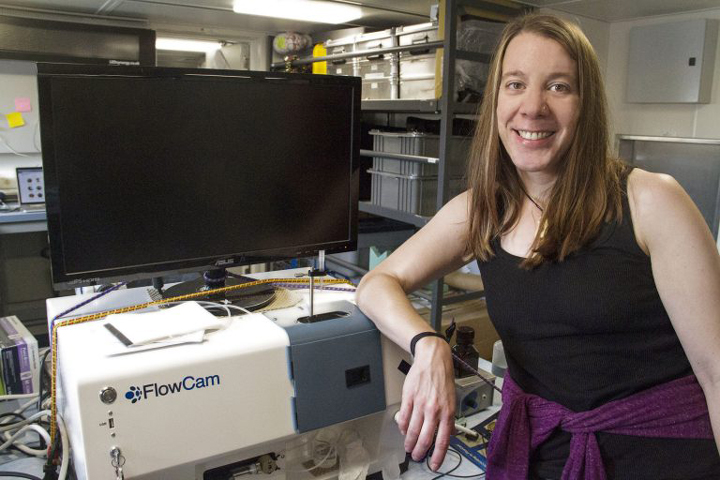
Aimee Neely, Biological Oceanographer, is studying particles using a FlowCam, an instrument that takes pictures of all the particles in the water flowing from a pump located in Falkor’s aft. SOI/Mónika Naranjo González
Phase 1: What Are Phytoplankton?
For an undergraduate project, I measured the response of several species of phytoplankton to different light intensities by measuring the concentration of their photosynthetic pigments, the compounds that collect light for photosynthesis. Pigments can also be used to identify specific groups of phytoplankton. During the second year of my Master’s program for marine biology, I participated in my first research cruise on a Canadian Coast Guard vessel that sailed from Dutch Harbor to Barrow, Alaska. I got my first taste of filtering, which is the collection of particles onto glass fiber pads that can be used for various analyses. Despite my initial bout of sea sickness in a near flat sea state, I was hooked.
In 2007 I pursued a research opportunity at the Bermuda Institute of Ocean Sciences where I was ship-bound once a month measuring the sulfur-based compounds made by phytoplankton that are thought to enhance cloud formation when they are outgassed to the atmosphere. For years, what I knew about phytoplankton was based on chemistry and physiology.
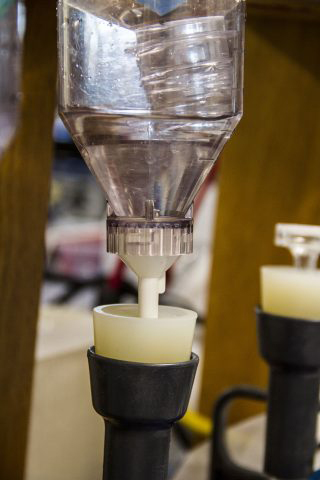
Samples filtered by Aimee will be processed back on land to measure different pigments in order to identify the planktonic organisms contained in it. SOI/Mónika Naranjo González
Phase 2: We Can Measure Phytoplankton from Space?
In late 2008, I left the beautiful island of Bermuda (crazy, right?) for Maryland to work at NASA Goddard Space Flight Center. Before this time, I knew nothing about satellites or ocean color remote sensing. While working at NASA I have learned that everything in the ocean – dissolved compounds, phytoplankton, and particles – absorb and scatter sunlight. Using this information about the color of the light reflecting out of the ocean, we can translate this light into information about what types of phytoplankton are in the water column.
High temporal and spatial resolution observations in the global ocean are just not feasible as we are limited by time and resources. Therefore, we make use of additional tools to fill in the gap for global and regional oceanographic observations. Satellite ocean color observations provide global ocean coverage, reaching time and space beyond our capabilities with research vessels and, therefore, may fill in the data gap where field measurements are limiting.

A satellite image shows Falkor’s track and the colors in ocean water. Colors indicate the amount of chlorophyll, where red is the highest and blue the lowest. SOI/Mónika Naranjo González
Phase 3: Learning How To See Phytoplankton
Ground truthing of these measurements of phytoplankton types through ocean color remote sensing is necessary but challenging. We can use phytoplankton pigments to derive a certain amount of information but the addition of microscopy is ideal, as then we can see which species are in the water. One of the newer technologies in the field is imaging flow cytometry, a technology that combines the best aspects of microscopy, flow cytometry and digital imaging.
Water is fed through the instrument at a specific magnification wherein a camera can be triggered to take a digital image of each particle or phytoplankter that passed by the field of view. Imagine how high spatial resolution of these data will help us to ground truth the phytoplankton type products that we retrieve from satellite imaging. On the RV Falkor, we have two forms of this technology to sample, not only the surface of the ocean, but also at depth. Having never spent much time in front of a microscope myself, I am learning so much from the skilled scientists around me who can look at an image and almost immediately identify to which genus and/or species the phytoplankton belongs. I hope to gain this knowledge as I learn and use this instrumentation.
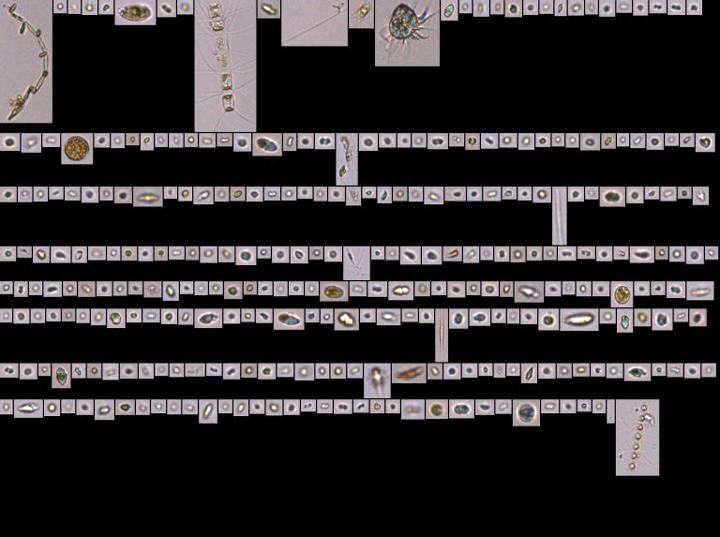
The Flow Cam is an instrument used by Aimee to identify particles in the water. Water is fed through the instrument at a specific magnification wherein a camera can be triggered to take a digital image of each particle or phytoplankter that passed by the field of view. SOI/Aimee Neeley
February 14th, 2017 by Mónika Naranjo González
Melissa Omand, interdisciplinary physical oceanographer from the University of Rhode Island’s Graduate School of Oceanography, was confronted with a conflict: it was time for an upgrade to her phone, but creating more technological trash did not feel right. Plus, the camera on her older phone was fantastic. Together with her first graduate student Noah Walcutt, she worked on optimizing better battery life, as well as fabricating an underwater housing and a lighting system for her “outdated” gadget. This to her remains the best part of her job: creating and testing new instruments, as well as repurposing existing ones.
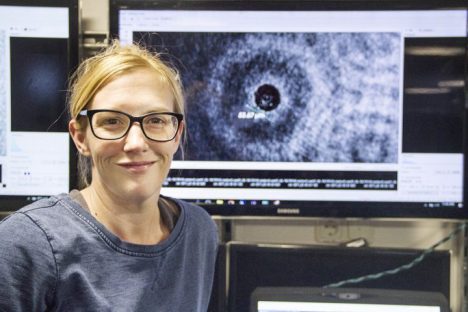
Creating and testing new instruments, as well as repurposing existing tools, are some of Melissa Omand’s favorite aspects of her job. Melissa is a Physical Oceanographer currently sailing on board R/V Falkor. SOI/ Mónika Naranjo González
Upcycling
Melissa and Noah are working with two different novel instruments in this cruise. The first one is a time-lapse camera developed after repurposing her previous mobile. The phone will dangle at the base of a 150 meter wire, deployed as part of the Wirewalker assembly. For three or four days, the camera snaps pictures of the base of a sediment trap which collects falling particles called marine snow. Up until now, Melissa and her colleagues Colleen Durkin and Meg Estapa have been able to identify what kind of particles fall into the traps (and at what time this happens) by analyzing the material preserved in a special gel. They have also learned that particles fall in pulses as opposed to a steady flow. However, they are still not sure about which types of marine snow sink with each pulse, and how these are connected to the phytoplankton community above. They hope the images taken by the camera will provide a new piece to complete the puzzle that is carbon storage in the ocean.
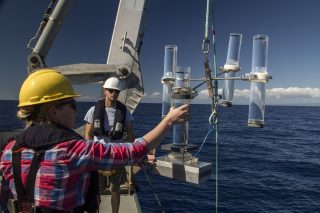
Melissa Omand deploys the sediment traps as part of the Wirewalker, while Oliver Hurdwell observes closely. SOI/ Mónika Naranjo González
Stepping in
A second novel instrument Melissa has brought on board is a holographic camera. Unlike traditional photography, a holographic image is obtained when a laser beam hits an object and either bounces off of it or goes through it, bending the light. More a computer than just a camera, the instrument combines diffraction data with math in order to reconstruct the light’s journey after interacting with the object (in this case, a planktonic organism). Tracing the behaviour of the light provides an enormous amount of information about the object’s characteristics in three dimensions. The result is an image that allows the experts to focus on different planes, and not in just one single depth of field.
This is interesting both because it vastly increases the volume sampled by enabling the scientists to choose where to focus on a picture that has already been taken, and in that it enables a very exciting application: Virtual Reality.
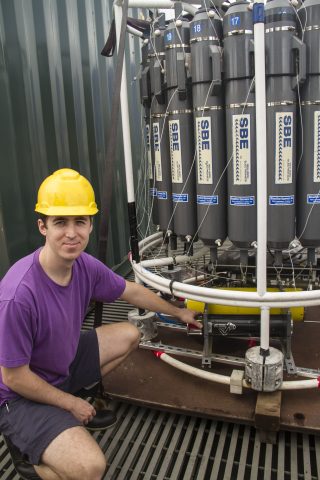
Noah Walcutt examines the holographic camera installed in the CTD rosette. The camera is able to capture around 40 000 images in a single CTD cast. SOI/ Mónika Naranjo González
Numbers, numbers…
Cut a single hair a hundred times and you will get something resembling the size of a few microns. That is the resolution that the holographic camera can capture in a single photo: 16 photos per second, 100 particles per hologram in average, 40 thousand holograms per dip in the ocean. The numbers begin adding up fast, so Melissa knows it is time once again to create something from scratch: their own pathway for data management, processing and analysis. This is why she began working with Ben Knorlein, a computer scientist from the Center for Computation and Visualization from Brown University.
Not only is Ben in charge of designing an efficient way to deal with all of the information yielded by the holographic camera, but he is also the mastermind behind the software that allows scientists to step into the holograms and interact with the particles in a Virtual Reality environment. This has been the first time Ben has ever been at sea. He assists researchers in the deployment and recovery of scientific instrumentation, and more importantly, he is gaining a deeper understanding of what they are looking for, becoming familiar with their thought process and expectations. All of this experience is vital for Ben to improve the software so scientists can have faster access to the information they need to extract from each holographic image.
No other ship could have given the team the opportunity to work efficiently with these images on board. Falkor’sHigh Performance Computer enables Ben to process tens of thousands of images in a single day, generating data immediately. Each day Ben sits at his working station in the Dry Lab, fine tuning parameters and settings to offer Melissa and Noah new options. Once back ashore, this cruise’s intense collaboration will have made the trio tighter than ever, and they will walk away from Falkor carrying invaluable new information, instruments and software.
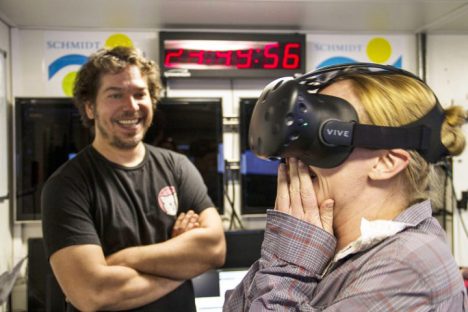
Ben Knorlein, Computer Scientist, observes Melissa Omand as she reacts to the first Virtual Reality experience created on board Falkor from holographic images of plankton suspended in the water. SOI/ Mónika Naranjo González
February 13th, 2017 by Stephanie Uz
Trying to sleep on a trampoline while somebody is jumping on it – this is how it feels during many nights at sea as the ship zig-zags in an imaginary box around our drifting instruments in the North Pacific during winter. This is when biological activity is lowest, but clearly there is no absence of physical forces, such as waves. Clearly.
The aim of this expedition is to find phytoplankton and measure their characteristics using light detectors, cameras and microscopes. From my perspective as an oceanographer who uses satellite data to explore large scale physical forcing of biology, this is a great chance to think about the smaller-scale forcing mechanisms that supply nutrients to the phytoplankton. And I am glad to get acquainted with the optical and biological instruments and methods being used and tested here at sea.

Hemispheric view by Suomi-NPP VIIRS on Feb 9, 2017 in true color. Clouds and airborne particles are white; ocean, blue. The ship’s track is shown in the red line. Station M is our last sampling site. NASA/ Norman Kuring
Slow Water, Low Biology
We began the campaign near Hawaii at the end of January in the North Pacific subtropical gyre, which has a predominate slow-moving circulation pattern that causes nutrient-depleted surface water. We experienced plenty of swell from distant storms – lab equipment had to be tied down, and chairs slid across the galley. Still, nutrient-rich deep water remained far below the well-mixed surface waters.
The water was exceptionally clear. Sunlight penetrated deeper than 150 meters (500 feet). In spite of the dearth of nutrients, our imaging systems revealed some phytoplankton! They appeared malnourished, but surprisingly diverse nonetheless.
In the absence of strong currents or other flow patterns, the Wirewalker instrument drifted westward making daily clockwise loops with the Earth’s rotation. I was excited to see its path mapped with inertial oscillations so clearly visible. Although they are always present, it is rare to see them this obviously as they are usually hidden by stronger forcing.
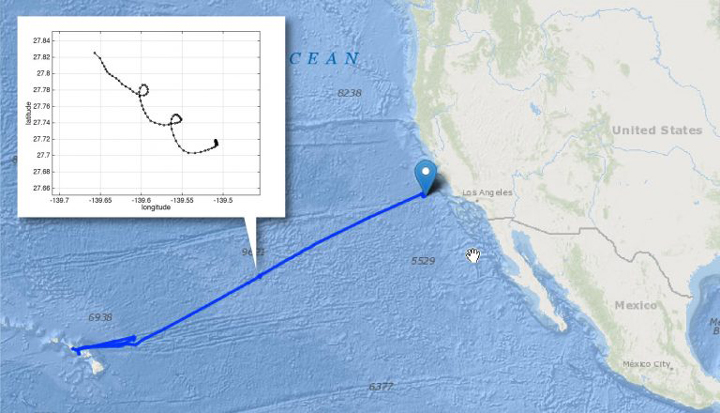
A plot of the Wirewalker’s track as it drifted freely at our second site for three days. Each point in the plot represents one hour. SOI/ Melissa Omand
Fast Water, More Biology
The end of our sampling campaign is approximately 250km (150 miles) west of central California over a site called ‘Station M.’ This location is typically more productive, being in the California Current that brings cooler water southward from the subpolar gyre.
Additionally, we arrived between low pressure frontal systems that have been pummeling the west coast with strong winds, rain and snow over the past month. These strong weather systems cause wind-mixing at the surface of the ocean, bringing nutrients up from depth. Sampling revealed a warmer, fresher top 30 meters (100m) above cooler, nutrient-rich water.
Immediately, the instruments monitoring phytoplankton and nutrients began registering significantly higher quantities than anything we saw earlier in the expedition: even more diverse and even more abundant. Collectively, this team has gathered an amazingly rich data set of measurements and images that makes the discomfort of sleeping on a trampoline all worth it.
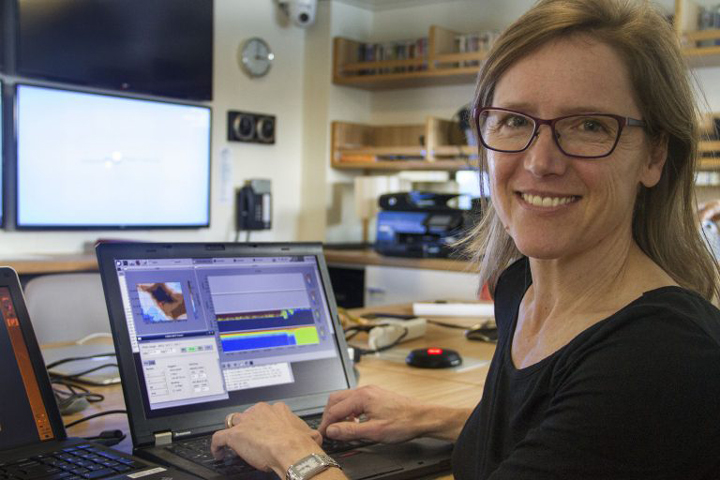
Stephanie Schollaert Uz monitors the speed and direction of water flowing under the ship with the Acoustic Doppler Current Profiler. SOI/ Monika Naranjo Gonzalez
February 11th, 2017 by Ryan Vandermeulen
Act 1: Blowin’ in the wind
At the unholy hour of 0400, I find myself on the aft deck of the world-class research vessel Falkor, bubbling with excitement stemming from a unique combination of four shots of espresso, generally being a morning person, and, most importantly, preparing to test an experimental device that I have put my blood, sweat, and tears into. As I bear-hug my newly collected bucket full of seawater on the rocking transit back to the wet lab, I take a moment to silently congratulate myself on the superb display of stamina and posture; it appears that my sea legs have finally decided to make an appearance. The sun will be coming up soon. It’s a Bob Dylan kind of day. Time to turn up the music and get to work.
Act 2: There ain’t no party like a plankton party

Ryan Vandermeulen, optical oceanographer, is testing this instrument at sea for the first time. The experimental “photosynthetron” (a.k.a. electro-squid 4000) serves as an incubation chamber for seawater samples. SOI/ Vandermeulen
In addition to being an eclectic lab DJ, one of my roles as a scientist aboard this righteously amazing research vessel is to investigate the rates of biological activity among microscopic communities within the ocean. The invitees to this epic microbial festival include bacteria, viruses, zooplankton, larval fish, and phytoplankton (algae). The photosynthetic members of this microscopic plankton community (PHYTO-plankton) are the base of a complex ocean food web, and have a large cascading ecological impact on the abundance and diversity of fisheries that we depend on. In addition, phytoplankton play a significant role in the global cycling of carbon, as well as the production of oxygen we breathe. Just like the plants in your garden, phytoplankton utilize carbon dioxide and micronutrients in the seawater – along with various light harvesting pigments which capture sunlight at different wavelengths – to create new cell bodies.
A byproduct of this magnificent life-giving process of photosynthesis is the production of oxygen, which we measure with great precision as a proxy for the amount of carbon that has been fixed into organic matter. The remaining (non-photosynthetic) members of this microbial party are not particularly polite dinner guests and have a tendency to exploit the kindness of our fearless photosynthetic community by eating the food that the phytoplankton have dutifully prepared, namely themselves (phytoplankton bodies) along with their subsequent secretion of dissolved organic matter (zooplankton are quite the sloppy eaters). We measure this microscopic massacre in the form of oxygen consumption, because, like us, these microbial heterotrophs need oxygen and organic matter that phytoplankton produce in order to live. Collectively, the ocean acts as one breathing organism as this process plays out, silently taking in copious amounts of carbon dioxide from the atmosphere and giving us oxygen that we breathe. This balance (or lack thereof) of carbon/oxygen uptake versus production lends us insight into the overall health or metabolic status of an ecosystem, in a way similar to taking the pulse of your body.

The Various light levels of the photosynthetron simulate different light conditions through the day, and the subsequent oxygen production/consumption is measured using optical sensors. SOI/ Vandermeulen
Act 3: Some telescopic insights into microscopic processes
One of the more confounding elements of studying oceanography is dealing with the fact that many measurements only tell us something about one very specific time and place in a very large and dynamic ocean. So, in addition to these experiments, we are monitoring the “color” of the ocean with continuous underway measurements of the reflectance of sunlight from the water. As sunlight hits the ocean, phytoplankton are capturing some of this light for photosynthesis, and they imperceptibly change the color of the water as light scatters back from the sea. Out in this near-barren desert of photosynthetic activity, we use a very precise radiometric measurement of over 100 wavelengths across the ultraviolet/visible spectrum to detect these subtle changes. As a NASA scientist, my other research life consists of using data from ocean-observing satellites that monitor changes in the color of the ocean over the entire globe every day. By understanding more about the link between biological activity that I’m measuring in the lab, the types of phytoplankton in the water, and how this changes the color of the ocean, we can refine how we monitor these processes from space, and thus increase our understanding of carbon cycle dynamics on a global scale. Just to re-iterate, we are literally monitoring the activity of microscopic organisms that are too small to see with the naked eye with a telescope orbiting our planet at over 15,000 mph to study climate scale processes. I think that’s pretty neat.
Act 4: Some microscopic insights into life, the universe, and everything
It’s been a long day, so I am going to wind down, grab my guitar, and serenade the sunset. They say if you sing to plants, they grow better, so there is some scientific merit to this ritual, mind you. Incidentally, our artist-at-sea, Kirsten, has inspired me through one of her onboard art + science seminars to try and take a more careful and purposeful look at the world around me. I will temporarily suspend the thought of Rayleigh scattering and radiative transfer equations as I watch the sun’s rays extend across the horizon. For now, I’ll just listen and observe.
February 9th, 2017 by Mónika Naranjo González
As an undergraduate student, Colleen Durkin had no idea what to specialize in, but looking at a seawater sample through a microscope during a field-trip to Friday Harbor Labs changed that forever. “I suppose I had used a microscope before, but I can’t remember it,” she shares. “All I know is that to this day, I can recall what that particular sample looked like, with all of its copepods and cells swimming around.” Colleen has never looked back: since then plankton has been the driver of both her career and curiosity from Undergraduate to Doctorate in Oceanography.
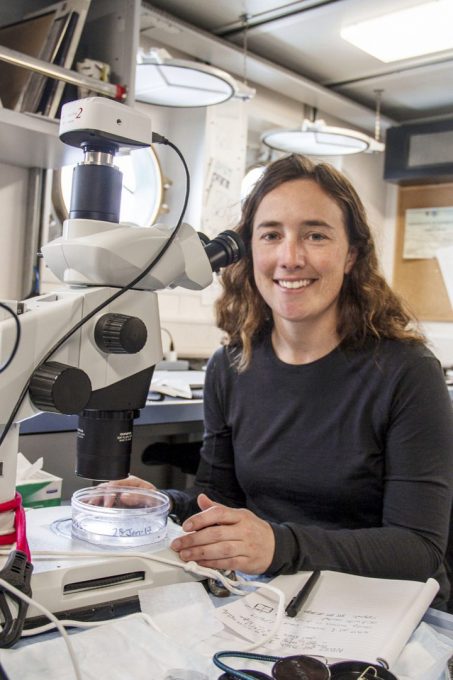
Colleen Durkin, Oceanographer, is studying particle size and distribution in order to relate it to the carbon cycle and the capacity of the ocean to store carbon. SOI/ Mónika Naranjo González
Diatoms
Diatoms are Colleen’s favorite phytoplankton, with good reason. Not only are they tiny yet incredibly complex, they are also beautiful organisms. Diatoms are capable of creating a glass shell, which bestows an almost fantastical quality upon them. “The glass has nano-scale structures,” says Colleen as she examines the image of a star-like cell. “They look like a work of design, like art.” Beyond their evident beauty, diatoms have a monumental impact on everyday life on planet Earth.

In order to synthesize silica (glass), diatoms carry out complex chemical processes, absorbing silicon available in the water. SOI/ Colleen Durkin
Take a Breath and Thank Plankton
One out of every five breaths taken by any (and every) life form on the planet comes from a diatom. Diatoms are a kind of phytoplankton: that is, microscopic plants drifting in all bodies of water. They carry out photosynthetic processes, ultimately producing oxygen in the air we breathe.
Half of the oxygen available to us has been produced by phytoplankton – this means that every other breath comes from microscopic organisms in the ocean. Getting to know them better, their processes, their current status, and how a changing climate will affect them is essential to us, because they are essential to life.
Although scientists have a general idea of the kinds of phytoplankton that can be found in different regions of the world at certain periods of the year, they do not yet have a complete understanding of phytoplankton communities’ full distribution. Furthermore, there is still much to be learnt about the chemical processes each planktonic group carries out. Falkor’s current expedition will help contribute to creating a baseline, connecting diversity with the processes each organism is responsible for. Humans are changing the Earth rapidly, and we need to be able to monitor and understand ocean communities before long-term changes occur.
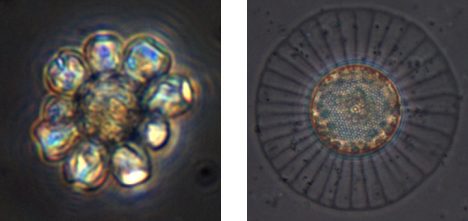
The specific chemical processes carried out by phytoplankton still need to be determined and studied. This is a microscopic picture of a coccolithophore (left). Diatoms (right) form silica shells. The reason behind this is still to be determined. One theory relates to protection from predators. SOI/ Colleen Durkin
Sea to Space
This Sea to Space Particle Investigation will allow an unprecedented view of ocean processes by using tools both in the ocean and satellites in the sky. Looking at the ocean from specialized satellites it is possible to detect colors, which help inform the presence of certain types of particles drifting in the water. This expedition will provide key information connecting the satellites’ data capturing with real time in-situ measurements. As a result, experts will improve algorithms for these satellites, allowing for better global estimates of oceanic biochemical processes.
Phytoplankton is a major foundation to nearly all known forms of life. It produces oxygen, regulates the climate and sustains the marine food chain – a fundamental source of protein for humans. At the same time, when these organisms sink, they drag carbon down to the depths of the oceans with them, counteracting the accumulation of carbon dioxide in the atmosphere. This is Colleen’s primary interest: carbon export from the air to the ocean. She knows she will never grow tired of studying phytoplankton, immersing herself in the fascinating chemical labyrinth that these creatures build – often out of sight.



















